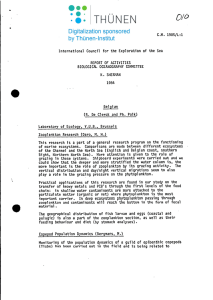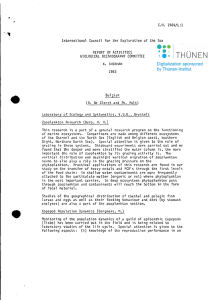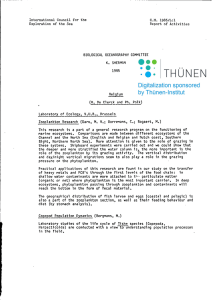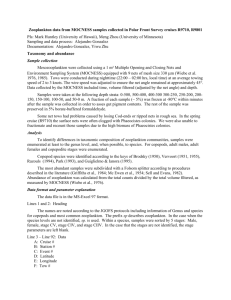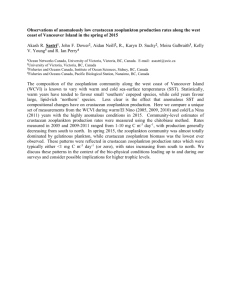Current Research Journal of Biological Sciences 1(3): 155-159, 2009 ISSN: 2041-0778
advertisement
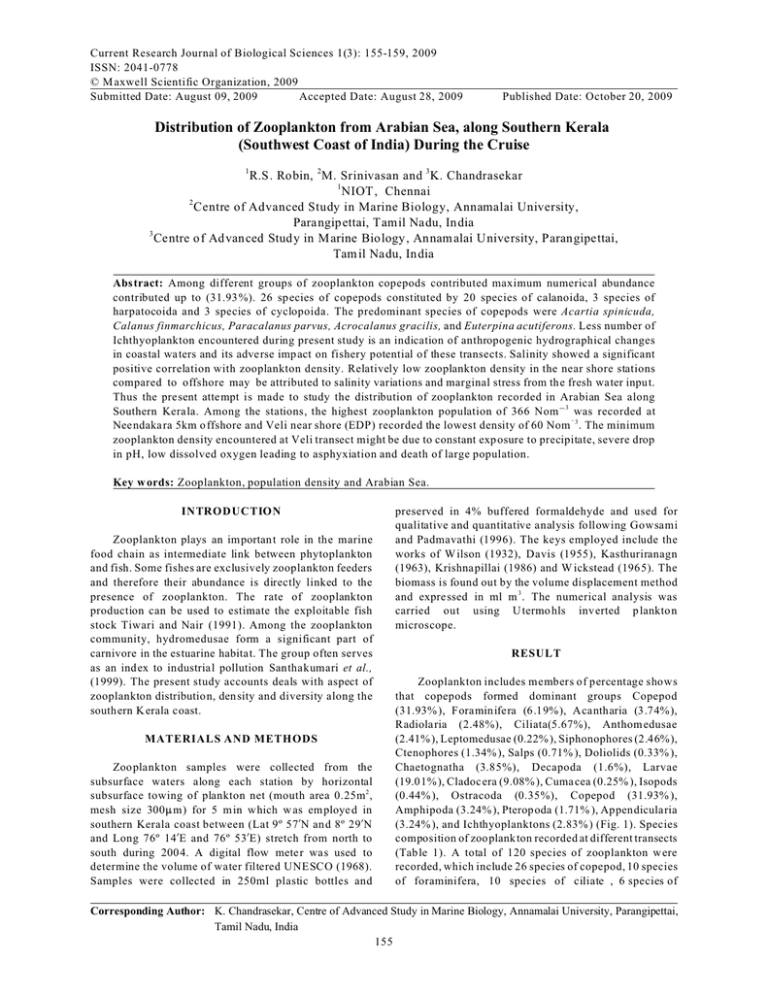
Current Research Journal of Biological Sciences 1(3): 155-159, 2009 ISSN: 2041-0778 © M axwell Scientific Organization, 2009 Submitted Date: August 09, 2009 Accepted Date: August 28, 2009 Published Date: October 20, 2009 Distribution of Zooplankton from Arabian Sea, along Southern Kerala (Southwest Coast of India) During the Cruise 1 R.S. Robin, 2 M. Srinivasan and 3 K. Chandrasekar 1 NIOT, Chennai 2 Centre of Advanced Study in Marine Biology, Annamalai University, Parangip ettai, Tamil Nadu, In dia 3 Centre of Advanced Stud y in Marine Biology , Annam alai University, Parangipettai, Tam il Nadu, In dia Abstract: Among different groups of zooplankton copepods contributed maximum numerical abundance contributed up to (31.93%). 26 sp ecies of copepods constituted by 20 species of calanoida, 3 species of harpatocoida and 3 species of cyclopoida. The predominant species of copepods were Acartia spinicuda, Calanus finmarchicus, Paracalanus parvus, Acrocalanus gracilis, and Euterpina acutiferons. Less number of Ichthyoplankton encountered during present study is an indication of anthropogenic hydrographical changes in coastal waters and its adve rse imp act on fishery potential of these transects. Salinity showed a significant positive correlation with zooplankton density. Relatively low zooplankton density in the near shore stations compared to offshore may be attributed to salinity variations and marginal stress from the fresh water input. Thus the present attempt is made to study the distribution of zooplankton recorded in Arabian Sea along Southern Kerala. Among the stations, the highest zooplankton population of 366 NomG 3 was recorded at Neendakara 5km o ffshore and Veli near shore (EDP) recorded the lowest density of 60 Nom G3 . The minimum zooplankton density encountered at Veli transect might be due to constant exp osure to precipitate, severe drop in pH, low dissolved oxygen leading to asphyxiation and death of large population. Key w ords: Zooplankton, population density and Arabian Sea. INTRODUCTION Zooplankton plays an importan t role in the marine food chain as intermediate link between phytoplankton and fish. Some fishes are exclusively zooplankton feeders and therefore their abundance is directly linked to the presence of zooplankton. The rate of zooplankton production can be used to estimate the exploitable fish stock Tiwari and Nair (1991). Among the zooplankton community, hydromedusae form a significant part of carnivore in the estuarine habitat. The group often serves as an index to industrial pollution Santhakumari et al., (1999). The present study accounts deals with aspect of zooplankton distribution, den sity and diversity along the southern K erala coast. MATERIALS AND METHODS Zoo plankton samples were collected from the subsurface waters along each station by horizontal subsurface towing of plankton net (mouth area 0.25m 2 , mesh size 300:m) for 5 min which w as em ploye d in southern Kerala coast between (Lat 9º 57!N and 8º 29!N and Long 76º 14!E and 76º 53!E) stretch from north to south during 2004. A digital flow meter was used to determine the volume of water filtered UNESCO (1968). Samples were collected in 250ml plastic bottles and preserved in 4% buffered formaldehyde and used for qualitative and quantitative analysis following Gowsami and Padmavathi (1996). The keys employed include the works of W ilson (1932), Davis (1955), Kasthuriranagn (1963), Krishnapillai (1986) and W ickstead (196 5). The biomass is found out by the volume displacement method and expre ssed in ml m 3 . The numerical analysis was carried out using U termo hls inverted p lankto n microscope. RESULT Zooplankton includes members of percentage shows that copepods formed dominant groups Copepod (31.93% ), Foraminifera (6.19%), Acantharia (3.74%), Radiolaria (2.48%), Ciliata(5.67%), Anthom edusae (2.41% ), Leptomedusae (0.22% ), Siphonophores (2.46%), Ctenophores (1.34% ), Salps (0.71% ), Doliolids (0.33% ), Chaetognatha (3.85%), Decapoda (1.6%), Larvae (19.01% ), Cladoc era (9.08% ), Cuma cea (0.25% ), Isopods (0.44% ), Ostracoda (0.35%), Copepod (31.93% ), Amphipoda (3.24% ), Pterop oda (1.71% ), Appendicularia (3.24% ), and Ichthyoplanktons (2.83% ) (Fig. 1). Species composition of zoo plank ton recorded at different transects (Table 1). A total of 120 species of zooplankton w ere recorded, which include 26 species of copepod, 10 species of foraminifera, 10 species of ciliate , 6 species of Corresponding Author: K. Chandrasekar, Centre of Advanced Study in Marine Biology, Annamalai University, Parangipettai, Tamil Nadu, India 155 Curr. Res. J. Biol. Sci., 1(3): 155-159, 2009 Fig 1: Percentage composition of dominant groups of zooplankton along southern Kerala coast Fig 2: Variation of zooplankton population (NomG 3) along the transects Table 1: List of zooplankton species recorded along the southern Kerala coast during October 2004. S.No Name of the species Tran sect I Trans ectII Trans ect III Trans ect IV Foraminifera 1 Am mon ia beccari + + + + 2 Ro salin a be rthelo ti + + + + 3 Epon ides repand us + + 4 Elphidium crispum + + + 5 Loxostomum limbatum + + + 6 Am phis tegin a ra diata + + + 7 Textularia candeiana + + + 8 Textularia agglutnans + + + 9 Bolivinitia quadrilatera + + + + 10 Globigerina sp. + ++ ++ ++ Ac an tha ria 11 Acanthochiasma sp. + ++ Radiolarians 12 Thalassicolla sp. + ++ Ciliata 13 Co don ellop sis os tenfe ldii + + + 14 Fa vella bre vis + + + 15 Fa vella phillip pen sis + + + 16 Fa vella eren ber gii + + + 156 Tran sect V T ra ns ec t V I + + + + + + + ++ ++ + + + + + + + ++ ++ ++ + + + + + + + + + + + Curr. Res. J. Biol. Sci., 1(3): 155-159, 2009 Table 1: Continued 17 Co don ellop sis ec aud ata 18 T. beroidea 19 Co xiella a mp la 20 T. cy lindr ical 21 T. dir ecta 22 T. tubulosa Anthom edusae 23 La odic ea u ndu lata 24 Sar sia ex imia 25 Bougainvillea sp. 26 Ph ialella qua dra ta Leptomedusae 27 Obelia sp. Siphonopho res 28 Muggiaea kochi 29 Lensia conoidea Ctenophore 30 Pleurobranchia pileus 31 Ber oe c um is Salps 32 Salp a fus iform is Doliolids 33 Doliolum gegenb auri Chaetognatha 34 Sagitta enflata 35 Kr ohn itta su btilis 36 S. ser rato den tata 37 S. zetesios 38 S. setosa 39 S. elegans Cladocera 40 Penilia avirostris 41 Po don leca rti 42 P. intermedius 43 Evadna normani 44 E.tergestina Cum acea 45 Diastylis sp. Isopods 46 Sphaeroma sp. 47 Idotea sp. Ostracoda 48 Conchoecia sp. Copepoda (a)C alon oidia 49 Acartia danae 50 A. spinicuda 51 Calanus finmarchicus 52 Tem ora disca uda ta 53 T. lon gico rnis 54 T. tur bina ta 55 Centerop ages furcatus 56 Acrocalanus gibber 57 La bido cera detru nca ta 58 Paracalanus parvus 59 Pseudocalanus elongatus 60 Pontella danae 61 Po ntello psis h erd ma ni 62 Euterpinna acutifrons 63 Eucalanus crassus 64 Acrocalan us gracilis 65 La bido cera acu ta 66 Eucalanus attenuatus 67 Paracalanus parvus 68 Temo ra stylifera (b)Harpacticoida 69 Euterpina acutiferons 70 Microsetella rosea 71 M . gra cilis C) C yclo po dia 72 Corycaeus nana + + + + + + + + + + + + + + + + + + + + + + + + + + + + + + + + + + + + + + + + + + + + + + + + + + + + + + + + + + + - + - - + + + + + + + + + + + + + + + + + + + + + + + + + + + + - + - + + + ++ + + + + + + + + ++ ++ + + + + + ++ + + + + + + + + ++ ++ + + + + ++ +++ + + + ++ +++ + + + ++ +++ + + + + +++ - + + +++ +++ + ++ +++ +++ + 0 + - - + + - + + - + - + - + + 0 + + + + + ++ ++ + + + + + + + + + + + +++ ++++ + + - + +++ +++ + + + +++ +++ + + + +++ +++ + + ++ +++ +++ + + - + + ++ + ++ + + ++ + + + + + + ++ + + + + ++ + + + + + ++ + + + + + ++ + + + + + ++ + ++ + + + + + + + + + + + + + + + ++ + + + + + + + ++ + + + + ++ + ++ + + + - + - + + + 157 Curr. Res. J. Biol. Sci., 1(3): 155-159, 2009 Table 1: Continued 73 Oithona rigida + + + 74 O. sim ilis + + + + Amphipoda 75 Gamm arus sp. + + + + 76 Corophium sp. + + 77 Metaprotella sp. + Pteropods 78 Creseis acicula + + + + 79 Cliona limacina + 80 Cavolina sp. Appendicularians 81 Oik ople ura dioc ia + + + ++ 82 O. fu siform is + + + ++ Decapoda 83 Lu lcifer h ans eni + ++ ++ ++ Larvae 84 Cop epod n auplius ++ ++ ++ ++ 85 Cypris larvae + 86 Cirripede na uplius + 87 Gastropod veliger + ++ ++ ++ 88 Bipinaria larvae + + + + 89 Echinopluteus larvae + + + 90 Bivalve viliger + + + + 91 Cyphonatues larvae + 92 Lamellibranch larvae + ++ +++ +++ 93 Nereid larvae s94 I zoea of crab + + + + 95 Decapod zoea + + + + 96 Megalopa of crab + 97 Mysis larvae + + + + 98 Penaed nauplius + + + + 99 Alima larvae + + 100 P. protozoea + + + ++ Ichthyoplanktons 101 Post larvae of stoleophorus sp. + + + + 102 Post larvae of Ambassis sp. + + 103 Egg of sardinella sp. + + ++ + 104 Egg o f stolephorus sp + + + + 105 Leiogna thidae daura + + + 106 Sardinella fimbriatta + + * Tran sect. I (C och in), *T rans ect. II (A llepp ey), * Tran sect. III (K ayam kula mm ), *T rans ect. IV (Ne end aka ra), *T rans ect. (Veli).“+” Denotes presence, “++” Denotes less abundant, “+++” D enotes Abundant, “–” Denotes absence. Chaetognatha, 5 species of Cladocera, 4 species of Anthomeusae, 3 species of A mphipoda, 3 species of Pteropoda, 2 species ea ch of Siphionopho re, Ctenop hore and Ap pen dicula rians. A ccan tharia, R adiola raia, Leptomedusae, Salps, Do liolids, Cumacia, Isopods, Ostracoda, and Dacapoda were represented by one species each. Whereas, 17 larval forms and 6 Ichthyoplanktons also were recorded and its biomass varied from 0.02 ml mG 3 at Veli near shore to 0.23 ml mG 3 at Neendakara 5 km offshore. The population density recorded as highest of 366 Nom G3 at Neendakara 5 km offshore and the lowest density of 60 Nom G3 in Veli near shore (EDP). Variations of zooplankton population at different stations were illustrated in Fig. 2. + + + + + + - + + + + + + - ++ + +++ ++ ++ ++ ++ + ++ + + + ++ + + + + + + + ++ ++ + + + + + + ++ + + + + + + + + + + + + + +s V ( pa ra vu r) , * T ra ns ec t. V I of changes in wa ter quality, beca use it is strongly affected by the environmen tal conditions and it is quickly responded to changes in environmental quality Gannon and Stemberger (1978). Saldeek (1983) reported that among zooplanktons crustaceans, cladocerans and copepods can used as the ind icator of aqua tic environm ent. Am ong the stations zooplan kton density ranged from 60 No mG 3 at Veli near shore (EDP) to 366 mG 3 at Neendakara 5 km offshore. Among different groups of zoo plank ton copepods contributed to the maximum num erical ab undance contributed u p to (31.93% ). In present survey a total of 22 group of zooplankton comprise of 106 species of zooplankton species were recorded and the order. The most common species of copepods were Acartia spinicuda, Calanus finmarchicus, Paracalanus gracilis, and Euterpina acutiferons. Such types of numerical abundance of copepods in various waters were studied by (G owsami, 1985a, b and Vijayalakshmi et al., 1983). The high zooplankton density at Neendakara waters might be due to relatively stable environmental conditions like optimal salinity, temperature, and good standing crop of phytoplankton prevailed in that region. And also at Neendakara, salinity showed a significant positive correlation with zooplankton density. Relatively low DISCUSSION Zooplankton community of a marine ecosystem comprises of heterogeneous assemblage of many an imals covering taxonomic groups. The distribution of zooplankton varies w ith the state of tide population dynamics is related to the physico-chemical factors. The zooplankton occupies a single position between the autotrophs and other heterotrophs and forms an important link in marine food web. Zooplankton is a good indicator 158 Curr. Res. J. Biol. Sci., 1(3): 155-159, 2009 zooplankton density in the near shore stations compared to offshore may attributed to earlier works of Asha et al.,(2002); Robin et al.,(2003). The minimum zooplankton density encountered at Veli transect might be due to constant exposu re to suspended precipitate, severe change in pH, low dissolved oxygen will cause prolonged sub lethal effects such as chocking of respiratory asphyxiation and consequently leads to the death of large population of zooplankton commu nity. This observation is similar to he findings of Abdul azis and Balakrishnan Nair (1981); Bijumon et al. (1998, 2000); Prijilal, (2003). In coastal waters tide can influence the qualitative and quantitative distributions of zooplankton. There was a shoreward increase in zoo plankton d uring food period and reverse trend experienced. Copepods and dec apods w ere the higher forms substantiate higher population during ebb period . W hile, Chaetognaths and Appendicularians caug ht app reciable number during the flood period. This conclusion is in agreeme nt with earlier observations at Maharashtra coastal waters by Gajbhiye et al., (1983). At Veli transect, very high numerical abundance of siphonophores was noticed indicating that the pollution thriving nature of that species especially low pH and high water temperature. Kamaeswara Rao et al., (1979) revealed that no foraminifera species were present in the beneath the acidic flacks and species diversity of foraminifera very low at vicinity of EDP area. Gajbhiye et al., (1991) has reported that Acartia spinicuda can thrive well in polluted environm ent and ap pears to be an indicator of marine pollution. Present study reveals that zooplankton density of southern Kerala coasts was affected by anthropogenic activities together with the industrial effluent discharge. This will lead ecological imbalance and there by corresponding fishery potential of these area. Gajbhiye, S.N., rosamma Stephan, Vijayalakshmi R N air and B.N Desai, 1991. Copepo ds of the near shore waters of Bombay. Indian. J. Mar. Sci., 20: 187-194. Gajbhiye, S.N., R.N. Vijayalakshmi, L. Krishna Kumari and B.N Desai, 1983. Effect to tide on the variability of zooplankton in the near shore w aters of Thal, Maharashtra. Indian J. Mar. Sci., 12: 166-173. Gannon, J.E., and R.S. Stemberger, 1978. Zooplankton especially crustaceans and rotifers as indicators of water quality. Trans. Am. Micros. Soc., 971: 16-35. Gowsami and Padmavathi, 1996. Zooplankton production, com position and diversity in the coastal waters of Goa. Indian J. Mar. Sci., 25: 91-97. Gowsami, S.C., 1985a. Secondary production and zooplankton abundance in coastal waters from Vengurla to Maipe, west coast of India. Indian J. Mar. Sci., 14: 85-92. Gowsami, S.C., 1985b. Zooplankton standing stock and composition in coastal waters of Goa, West coast of India. Indian J. Mar. Sci., 14: 177-180. Kam aesw ara Rao., K. and T.S. Sathyanarayana Rao, 1979. Studies on pollution ecology of foraminifera of the Trivandrum coast. Indian J. Mar. Sci., 8: 31-35. Kasthu riranagn, L.R., 1963. Key to the identification of the com mon pelagic copepods of Indian coastal waters. CSLS publication, pp: 128. Krish napillai, N., 1986. Introduction of planktonology, Himalaya publishing House, pp: 85-105. Prijilal, K.G., 2003. Impact assessment of marine pollution in Veli coast, Thiruvananthapuram district Kerala. M.Phil.dissertation, University of Kerala. India. Robin, R.S., A.Sa jith Ku mar, B .S. Asha and C.S. Satheesh Kumar, 2003. Nutrient dynamics and plankton characteristics in the marine environment of Neendakara, Proceeding of the fifteen th Kerala Science Cog., pp: 574-580. Saldeek, V., 1983. Rotifers as indicators of water quality. Hydrobiologia, 100: 167-201. Santha kum ari, V.L ., R Tiv ari and R.N . Vijayalakshmi, 1999. Species compo sition, abundance and distribution of hydromedusae from Dharamtar estuarine system, adjoining Bombay Harbor Indian. J.Mar.Sci., 28: 158-162. Tiw ari, L.R. and V.R. Nair, 1991. Contribution of zooplankton to the fishery of Dharamtar creek, adjoining Bombay harbor. J. Indian Fish. A ss., 21: 15-19. UN ESC O., 1968. Zooplankton sampling. Monographs on ocea nographic methodology UNESCO Publication, (2): 174 . Vijayalakshmi R Nair., S.N. G ajbhiye, L. K rishnakum ari and B.N.Desai, 1983. Biom ass and composition of zooplankton in near shore waters of Thal, Maharashtra. Indian J. Mar. Sci., 12: 160-165. W ickstead, J.H., 1965. An introduction to the study of tropical plankton. Department of technical co–operation and m arine biological association. Plym outh. p p: 160 . W ilson, C.B., 1932. The copepod of the w oodshols region. Massachusetts. Smithinian institute, U.S. Natl. Mus. Bull., 158: 1-635. REFERENCE Abdul Azis, P.K. and N.B.Nair, 1981. Certain aspects of pollution in the aquatic ecosystems of the Southwest coast of India. Proceeding of seminar on status of environm ent stud ies in Ind ia. pp: 345-356. Asha, B.S., C.S. Satheesh kumar and P.P. Ouseph, 2002. Plankton characteristics in the marine environment of Cochin. Proceeding of the 14 th Kerala science cong., pp: 435-438. Bijumon, K.B ., G. M adhusoo danan Pillai and P.P.Ouseph, 1998. Environmental degeradation of marine ecosystem at Veli due to the discharge of TTP effluen ts along the South West coast of India. Proceeding of the tenth Kerala Science Cong., pp: 384-386. Bijumon, K.B., S Robin, S.Sunil Kumar and P.P.Ouseph, 2000. Effect of factory effluent on the Biological productivity of coastal marine system at Veli, Thiruvananthapuram. Proceedin g of the tenth K erala Science Cong., pp: 205-207. Davis, C.S., 1955. The marine and freshwater plankton. Michigen state University Press, pp: 562. 159

